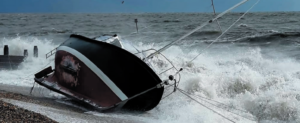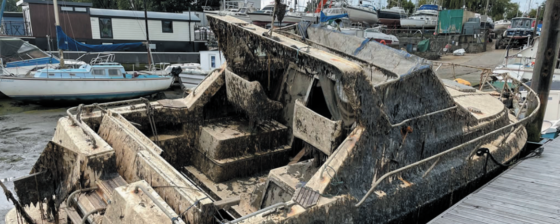
Industry insight: End-of-life vessels – time for action?

End-of-life boats – and what to do with them – are more than a pressing concern. They’re a small, but relentless, environmental disaster creeping along our shores…
The European Boating Industry (EBI) recently authored an article* , stating it’s spearheading discussions. But, is there still time for discussion? Luke Edney, communications manager for Boatbreakers, warned about too much talk and too little action in Marine Industry News (Feb 2020). The marine industry, he said, suffered from sloping shoulders when it comes to end-of-life boats, and what was needed was a “common plan and a strong lead” to avoid the UK’s shores becoming a “dumping ground”.
At the time, British Marine had end-of-life on its National Agenda 2020 and said that one of its 2019-20 objectives was to ‘create a new environment roadmap bringing up-to-date structure to its approach on key issues such as air quality, pollution control and end-of-life vessels’. And while that roadmap has been published, Edney says he is still waiting for sight of anything which says what is actually going to change.
And what’s worse, he’s predicting that the problem is about to ramp up exponentially. “One of the common conversations we are having with older boat owners is that covid has become the last straw in their decision to scrap their boat,” says Edney. “Everyone has had months away from their boat, but the bills still needed to be paid. Even now with the lifting of restrictions and widely available vaccines many owners have decided to cut their losses.
“I think it’s fair to say that many boatowners in the UK are in the older demographic. So to see so many people parting with their boats due to the pandemic is a shame.

“Another big trend seems to be people buying boats for the first time. With holidays being almost impossible this year people are getting into boating.”
While Edney welcomes this wave of new-found enthusiasm, he wonders whether people will stick or twist when a foreign holiday is on the cards again. Especially if those new boat owners are committed to expensive mooring fees. EBI’s secretary general, Philip Easthill, estimates that the number of boats actually available for dismantling, across the EU, is 30-40,000 per year. “95 per cent of the European boat park is estimated to be made of composites also known as FRP,” Easthill says. “This material ensures that boats last longer… meaning that there are many composite boats built in the 1970s that will reach their end of life in the upcoming years. However, while solutions to recycle composite boats exist, these are not economically viable.”
Easthill says there is a plan in place to tackle this in Europe, and work is progressing among composite industries to find common solutions. Within this, the organisation is promising a roadmap. “By the end of 2022, the joint objective of the European Commission and EBI is to establish a roadmap for EU action on the matter. It will deal with the entire life cycle of recreational boats, from dealing with the existing stock of boats through dismantling and recycling, as well as identifying the future sustainable composite materials,” Easthill says.
Ross Wombwell, head of technical services at British Marine, says its end-of-life working group is identifying specific challenges around how the UK can manage a long-term strategy to stop vessel abandonment, and manage a nationally accessible, financially viable and environmentally friendly process of disassembly and disposal.
On the table, according to the published British Marine roadmap, is a national database for registration and ownership of privately owned vessels, as currently there is no accountability for abandoning a vessel; the development and creation of proper facilities for the responsible disposal, recycling and reuse (where practicable) for end-of-life vessels; and legislation to incorporate accountability and responsibility for owners of vessels. Plus, there’s the push towards a circular life cycle where built-in financial consideration for disposal is part of the cost – including for small recreational craft like dinghies and RIBS. Wombwell says that existing research projects, experiences of other countries’ programmes, and engagement with other sectors is also being taken into account.
*Compositi Magazine, June 2021
